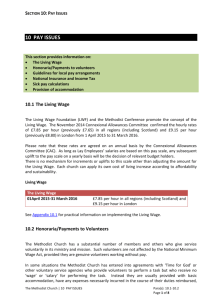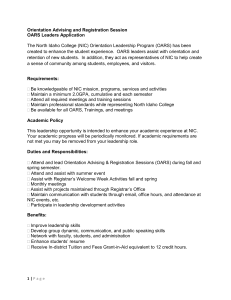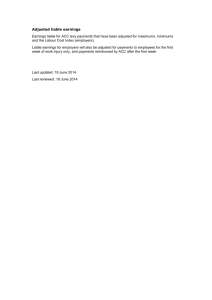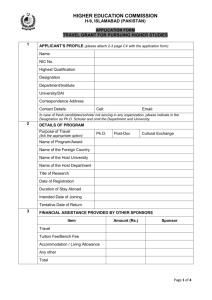National Insurance
advertisement
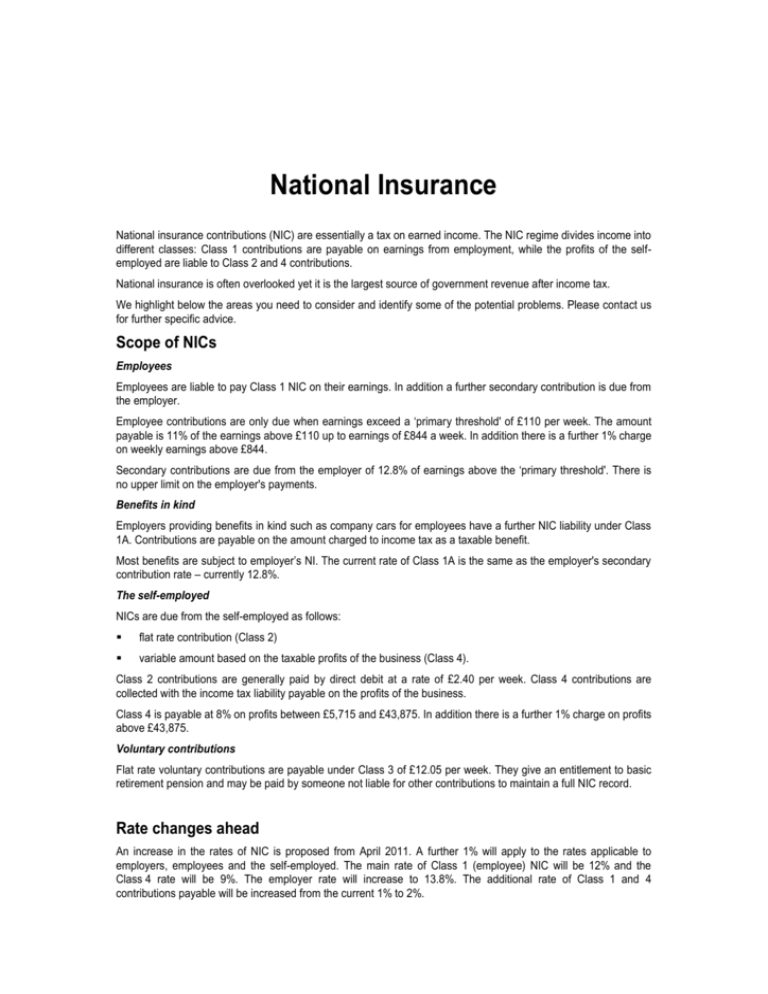
National Insurance National insurance contributions (NIC) are essentially a tax on earned income. The NIC regime divides income into different classes: Class 1 contributions are payable on earnings from employment, while the profits of the selfemployed are liable to Class 2 and 4 contributions. National insurance is often overlooked yet it is the largest source of government revenue after income tax. We highlight below the areas you need to consider and identify some of the potential problems. Please contact us for further specific advice. Scope of NICs Employees Employees are liable to pay Class 1 NIC on their earnings. In addition a further secondary contribution is due from the employer. Employee contributions are only due when earnings exceed a ‘primary threshold' of £110 per week. The amount payable is 11% of the earnings above £110 up to earnings of £844 a week. In addition there is a further 1% charge on weekly earnings above £844. Secondary contributions are due from the employer of 12.8% of earnings above the ‘primary threshold'. There is no upper limit on the employer's payments. Benefits in kind Employers providing benefits in kind such as company cars for employees have a further NIC liability under Class 1A. Contributions are payable on the amount charged to income tax as a taxable benefit. Most benefits are subject to employer’s NI. The current rate of Class 1A is the same as the employer's secondary contribution rate – currently 12.8%. The self-employed NICs are due from the self-employed as follows: flat rate contribution (Class 2) variable amount based on the taxable profits of the business (Class 4). Class 2 contributions are generally paid by direct debit at a rate of £2.40 per week. Class 4 contributions are collected with the income tax liability payable on the profits of the business. Class 4 is payable at 8% on profits between £5,715 and £43,875. In addition there is a further 1% charge on profits above £43,875. Voluntary contributions Flat rate voluntary contributions are payable under Class 3 of £12.05 per week. They give an entitlement to basic retirement pension and may be paid by someone not liable for other contributions to maintain a full NIC record. Rate changes ahead An increase in the rates of NIC is proposed from April 2011. A further 1% will apply to the rates applicable to employers, employees and the self-employed. The main rate of Class 1 (employee) NIC will be 12% and the Class 4 rate will be 9%. The employer rate will increase to 13.8%. The additional rate of Class 1 and 4 contributions payable will be increased from the current 1% to 2%. In order to protect those at the lower end of the earnings scale the government has announced that the primary threshold and lower profits limits will be increased. The upper earnings limit and the upper profits limit will continue to be aligned with the income tax higher rate threshold (which is being reduced in April 2011). Additionally, the level at which employers start to pay NICs will increase by £21 per week above indexation Potential problems Time of payment of contributions Class 1 contributions are payable at the same time as PAYE ie monthly. Class 1A contributions are not due until 19 July after the tax year in which the benefits were provided. It is therefore important to distinguish between earnings and benefits. Earnings Class 1 earnings will not always be the same as those for income tax. Earnings for NI purposes include: salaries and wages bonuses, commissions and fees holiday pay certain termination payments. Problems may be encountered in relation to the treatment of: expense payments benefits in kind. Expense payments will generally be outside the scope of NI where they are specific payments in relation to identifiable business expenses. Round sum allowances give rise to a NI liability. In general benefits are not liable to Class 1 NIC. There are however some important exceptions including: most vouchers stocks and shares other assets which can be readily converted into cash the payment of an employee’s liability by an employer. Directors Directors are employees and must pay Class 1 NIC. However directorships can give rise to specific NIC problems. For example: directors may have more than one directorship fees and bonuses are subject to NIC when they are voted or paid whichever is the earlier directors’ loan accounts where overdrawn can give rise to a NIC liability. We can advise on the position in any specific circumstances. Employed or self-employed The NIC liability for an employee is higher than for a self-employed individual with profits of an equivalent amount. Hence there is an incentive to claim to be self-employed rather than employed. Are you employed or self-employed? How can you tell? In practice it can be a complex area and there may be some situations where the answer is not clear. In general terms the existence of the following factors would tend to suggest employment rather than self-employment: the ‘employer’ is obliged to offer work and the ‘employee’ is obliged to accept it a ‘master/servant’ relationship exists the job performed is an integral part of the business there is no financial risk for the ‘employee’. It is important to seek professional advice at an early stage and in any case prior to obtaining a written ruling from HMRC. If HMRC discover that someone has been wrongly treated as self-employed, they will re-categorise them as employed and are likely to seek to recover arrears of contributions from the employer. Enforcement HMRC are expected to make over 100,000 compliance visits each year in an attempt to identify and collect arrears of NIC. They may ask to see the records supporting any payments made. HMRC have the power to collect any additional NIC that may be due for both current and prior years. Any arrears may be subject to interest and penalties. Please contact us for advice on NIC compliance and ways to minimise the effect of a HMRC visit. How we can help Whether you are an employer or employee, employed or self-employed, awareness of NIC matters is vital. HMRC have wide enforcement powers and anti-avoidance legislation available to them. Consequently it is important to ensure that professional advice is sought so that all compliance matters are properly dealt with. We would be delighted to advise on any compliance matters relevant to your own circumstances so please contact us. For information of users: This material is published for the information of clients. It provides only an overview of the regulations in force at the date of publication, and no action should be taken without consulting the detailed legislation or seeking professional advice. Therefore no responsibility for loss occasioned by any person acting or refraining from action as a result of the material can be accepted by the authors or the firm.




